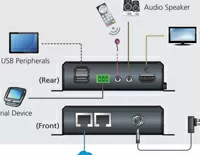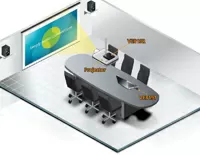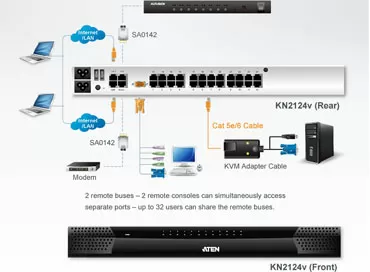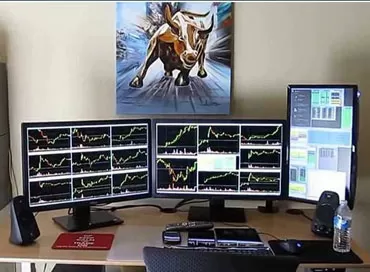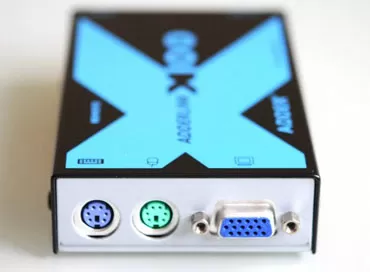Aten continuous matrix switches: testing the switching speed
In a professional environment, matrix switches are usually called simply "matrix" and denoted by the numbers 4x4, 8x8, or 16x16, where the first is the number of inputs, and the second is the number of outputs, and their number may differ. The main task of such a switch is to switch the supply of video content in different configurations:
- from one input to one output
- from a single input to multiple outputs
- from one input to several outputs, which are a video wall
- from one input to several outputs that are a video wall, but without any segment

Under real-world operating conditions, devices with different resolutions and frame rates are connected to the switch input: some of the presenters have an old Macbook with 1080p output via adapters, someone has a new Dell with 4K output, a permanently installed TV set-top box can produce a resolution of 720p or 1080p, in General-a complete hodgepodge. At the output, TVs and monitors have their own constant resolution, and previously, each input and output switch was accompanied by matching parameters between the same laptop and the TV, which took several seconds during which the active screen did not show an image, and in the professional environment these few seconds were called "black field". Even a short-term image loss not only reduces the comfort of work, but also acts as an additional irritating factor, especially if we are talking about the nervous work of emergency situations centers, dispatching services, and just about some operational meeting.
Lyudmila Ignatova, General Manager of the leading IT integrator, TEGRUS, will tell us about the use of matrix switches in modern installations:

HWP: For what typical installations used matrix switches of the video signal? Who most often is their consumer - state or commercial organizations..
TEGRUS: Matrix switches are often used in large conference rooms, Board rooms, situation and dispatch centers. In other words, where there are many sources of video signal that need to be processed and shown to many users. The task of a matrix switch is to quickly redirect video content to the desired device, whether it is a personal computer, desktop monitor, video wall, and so on.
These solutions are used, if necessary, both in projects for government agencies and commercial organizations. It all depends on the required functionality and complexity of the system created for the customer. In the business sphere, projects are more diverse, but less large-scale than in public institutions – cases of using switches with dimensions larger than 32x32 HDMI are quite rare. Government agencies, in turn, often use large matrix optical switches, in particular for building infrastructure on campuses under construction or for centralized content management in a large number of premises
Modern Aten "matrices" already use the technology of so-called "seamless" or "continuous" switching, in which the change of video signal sources occurs instantly, without the ill-fated "black field" and even without blinking. Structurally, this was achieved by buffering each video output and installing its own processor on it. The matrix switch coordinates resolutions and frame rates with connected TVs and projectors only once when turned on, and then all manipulations with the video stream are performed by the matrix video processor with frame-by-frame accuracy. We can say that at the electrical level, the modern "matrix" no longer commutes anything - the installed processors are powerful enough to not only replace one video stream with another, but also change the resolution of the input signal and scale the image while maintaining proportions. In the photo below, you can see what The Aten Seamless Switch technology looks like at the electronics level: the processor itself plus 256 MB of buffer memory accumulated by two Samsung k4b1g1646g-BCK0 chips, and so on - for each output.

It is important to note that this process does not use compression of the video stream, so the quality remains unchanged, and the black borders on the edges of the screen can be removed by zooming, making the adjustment once, and regardless of the incoming signal.
Aten VM6404H testing
Of course, without compression, the most" difficult " for the matrix switch is the mode of switching sources with different resolutions and frame rates. for example, not all matrix switches on the market still support continuous switching, if for example the connected TV has a scan frequency of 60 Hz, the active source is 30 Hz, and the new one is 25 Hz. In Atm switches, this feature is a source of pride for the developer, but you won't believe it until you see It with your own eyes, so we will test this feature on the example of Aten VM6404H.
Start by checking the delay between the input signal and the output to figure out how the buffering and processing in real time affects the comfort of work, it will submit to the HDCP input signal is 1080p @ 25 Hz, and the output will use a panel with a resolution of 4K @ 60 Hz, start timer accurate to thousandths of a second and fix the difference in meter readings.
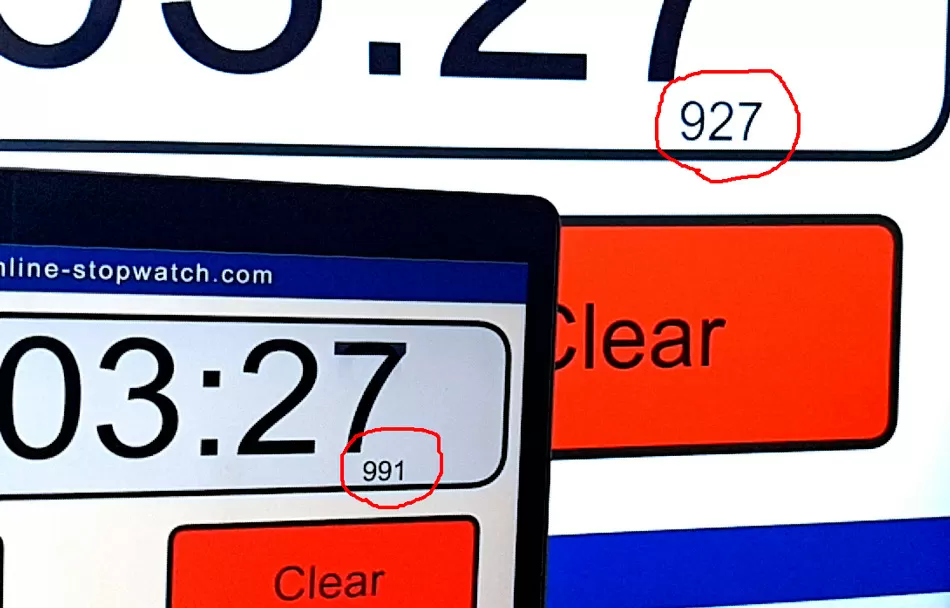
As you can see, the delay is 0.064 seconds, which is about 1.5 frames in a movie theater.
Switching in seamless matrix switches Aten occurs according to the following principle: at the time of giving the command to change the source, the last frame from the old input is saved in the buffer and the video stream is replaced with the new active one, with the necessary resolution and frequency correction. Using a timer, we can calculate the speed of this process.
On the right screen, we can see that the switch command was triggered at the value 0: 22: 55.236, after which the broadcast signal is no longer sent to the right output, and the matrix keeps a cached frame on the screen, making the switch. If the value is 0: 22:55: 335, the frame replacement process starts and ends at 0: 22:55: 367. If you look even more closely, you can see that the replacement itself occurs through a smooth transition from frame to frame. Connected TVs have a response time of 16 MS, and it is likely that here we are dealing with a situation where a professional video panel responds to frame changes more slowly than the switch. In total, the process of switching Seamless Switch to ATEN VM6404H takes 0.131 seconds, and if you count from the beginning of showing the buffered frame to showing the new source, then approximately 0.1 seconds. From the point of view of the observer - instantly. At the time of the review, continuous switching technology was present in the following Aten matrix switches:
- VM51616H - 16x16, 1080p, HDCP 1.4, 3D, DeepColor
- VM6809H - 8x9, 4K, HDCP 2.2, 3D, DeepColor
- VM3404H - 4x4, 4K, HDCP 1.4, 3D, DeepColor, HDBaseT
- VM3909H - 9x9, 4K, HDCP 1.4, 3D, DeepColor, HDBaseT
- VM6404H - 4x4, 4K, HDCP 2.2, 3D, DeepColor
- VM5404H - 4x4, 1080p, HDCP 1.4, 3D, DeepColor
- VM5808H - 8x8, 1080p, HDCP 1.4, 3D, DeepColor
- VM5404D - 4x4, DVI, 1920x1200
- VM58085D - 8x8, DVI, 1920x1200
- VM3200 и VM1600A*
*The modular VM3200 and VM1600A support bezels on all types of output boards. In the case of HDBaseT boards (as well as in the case of the VM3909H and VM3404H matrices, there is no breakout on the HDBaseT outputs themselves, it is provided by separate scaling receivers (VE805R or VE816R), while there is no breakout on the duplicate HDMI outputs of the VM3909H and VM3404H matrices.
We will ask the integrator how important it is to have seamless switching:
HWP: How important is it for the customer to have instant signal switching without going through the "black field"? Do customers have requirements for switching speed?
TEGRUS: the So-called "continuous switching" of sources is important today, because in modern meetings, speakers often switch signal sources several times in a short time. Any delay or a black screen that occurs for a short time creates the effect of system congestion and reduces the overall effect of the presentation. Therefore, today all popular matrix switches have the function of continuous switching of sources.
As a rule, customers do not make requirements in "m\s", but we must remember that in any modern video switch, delays are insignificant fractions of a second, so these requirements may be irrelevant.
HWP: How important is the ability to change the resolution between sources and screens on the fly in such installations? Are "margins" allowed at the edges of the image when changing the resolution, or do customers require that the image be perfectly expanded to the entire screen area?
TEGRUS: when buying a video wall, the Customer certainly expects 100% use of the entire usable area. If there are some fields that are not filled in with content, this can only indicate an incorrectly selected switching solution. All signal sources must maintain the same proportions as consumers (for example, 16: 9 in the case of Full HD), in which case no fields should occur. To avoid possible problems of this kind, we always try to unify the resolution from Full HD to 4K, depending on the Customer's requirements.
The Aten VM6404H matrix switch can be controlled from the front panel using buttons if the device is installed on the operator's Desk. Remote control is performed both via RS-232 when using the Aten VK2100 controller (this will be discussed below), and via the Web interface, which is more convenient in small installations.
During the initial setup, you configure the profile: sets the configuration of display panels, scaling of the video wall, and EDID parameters that the matrix will report to connected signal sources in order to exclude the use of unsupported resolutions (for example, interlaced). You can also specify HDCP installation parameters here, for example, to let your laptop know that HDCP is not supported.
Each designer of a meeting room or VKS system strives to place the switching equipment as close as possible to the screens and video signal sources, but the customer does not always agree to sacrifice the useful area of the room for the server Cabinet. In such cases, the HDBaseT standard is used, transmitting audio and video data, as well as control signals and a local network over a distance of up to 100 meters in 4K resolution or 150 meters 1080p in Long Reach mode over a conventional twisted pair of category 5/6. In Aten matrix switches, HDBaseT ports are used in conjunction with HDMI interfaces, allowing you to simultaneously display a picture on near and far screens. If you are viewing video in a neighboring room via HDBaseT, you will probably have a question of controlling video players from a conventional IR remote. The HDBaseT interface allows you to transmit back control signals via a twisted pair, but from the TV to the video player. To do this, IR transmitters are connected to the matrix switch, which can be sent to the video player to broadcast signals from the remote control.
Some video extenders supported by HDBaseT
- VE801 - 4K
- VE802 - 4K, continuous switching, IR control
- VE811 - 4K
- VE812 - 4K
- VE814 - 4K
- VE601 - 1080p
- VE901 - 4K
- VE805, VE816R - receivers with a video wall function that only work in conjunction with matrix switches with HDBaseT outputs. 1080p resolution support, continuous switching, video wall function, IR control
Some TVs have an HDBaseT input, and to connect most panels and projectors at a considerable distance, a simple scheme is used: the signal from the matrix switch is output via a shielded twisted pair to the TV, and a receiver from The set of Aten video extenders is installed next to it. The VE802R receiver model, for example, supports Power Over HDBaset mode, in which the matrix switch itself transmits electrical power with a budget of up to 15.4 W over the same twisted pair as the video signal.
ATEN VK2100 management controller
You have set up a video wall, suspended monitors and projectors, but there is only a little left - to set up control of electric curtains, screen and lighting from your smartphone. In large conference rooms, a separate operator is responsible for managing the video system, who, as a conductor, selects and directs cameras, switches video broadcasts, and can simultaneously transfer the microphone between different speakers. Ideally, it does not have access to the matrix switch settings, but manages its operation via an application installed on a tablet or via the web interface. To make it easier for the operator, Aten controllers have the ability to create their own graphical interface for managing the conference room using the Aten Control System App. In this application, you can create your own control map - you only need to draw a diagram of your room on a Windows computer, select virtual buttons and assign them the appropriate terminal commands, after which you can load the map to the controller and control devices from your tablet by clicking clear icons, whether they are photos of speakers or symbols like "big screen".
Aten VK2100 manages any devices that have an RS232 port or access via Telnet, TCP, UDP, ONVIF, and PJLink. Today it is almost all professional equipment: projectors, video panels, automatic curtains and blinds, and lighting controllers. If one of the devices does not have either RS232 or Telnet input, it can be controlled by training Aten VK2100 to transmit commands in the IR range.
Using the Aten VK2100, you can set up automatic actions, for example, so that when you turn on the microphone in the collegiate hall, you switch to another camera that takes pictures from a different angle, change the zoom level and/or dim the light.
HWP: is it Important for customers to have unified management through a single eco-system of signal switches?
TEGRUS: Yes, it is important, but we must remember that another system is responsible for managing the same switches - the control and automation system, with its own set of equipment. Matrix switch manufacturers themselves often have management and automation solutions in their portfolio. The most famous suppliers of such systems are Crestron, Extron, and AMX.
The switching capabilities of the Aten VK2100 can be enhanced by connecting additional interface extenders:
- VK248 - 8 channels relay
- VK236 - 6 infrared signal ports / RS232
- VK224 - 4 bidirectional channels RS232
Communication between the Aten VK2100 head unit and the interface extenders is carried out over a local Ethernet network.
Main service issues and customer requirements: integrator's experience
In addition to large state-owned companies, customers of matrix switches are also sports bars, where you need to display the broadcast from one satellite receiver to a dozen screens on a large area, and educational organizations that use interactive training programs.
HWP: How popular is support for 4k and 3D resolutions? How important is the lack of compression and perfect image quality for customers?
TEGRUS: support for 4K today is almost the main requirement of the Customer, because you need to look to the future and focus on formats that will be relevant in a few years. As for 3D technologies, they can be a mandatory integral part of the project, for example, when building a training center, or are considered as possible additional equipment for a conference hall or other room. The lack of compression plays a big role when displaying presentation materials or graphs, maps, or visualizations. To date, all the switches we use produce a perfect picture.
HWP: Are customers ready to independently service such implemented projects, for example, to change one screen or TV to another, to connect additional screens?
TEGRUS: These systems are quite complex in switching and maintenance, so we, as an integrator, always pay serious attention to training the Customer's employees to work with installed systems. In some cases, this training is sufficient, but not for the most complex operations, such as: switching sources and adding new ones, changing the screen layout, and so on. In this case, as a rule, the Customer chooses the appropriate service from the integrator, where certain conditions are laid down (within the SLA). In practice, this is cheaper than having a staff of specially trained people who are ready to solve various problems that arise.
HWP: How important is the ability to change the resolution between sources and screens on the fly in such installations? Are "margins" allowed at the edges of the image when changing the resolution, or do customers require that the image be perfectly expanded to the entire screen area?
TEGRUS: when buying a video wall, the Customer certainly expects 100% use of the entire usable area. If there are some fields that are not filled in with content, this can only indicate an incorrectly selected switching solution. All signal sources must maintain the same proportions as consumers (for example, 16: 9 in the case of Full HD), in which case no fields should occur. To avoid possible problems of this kind, we always try to unify the resolution from Full HD to 4K, depending on the Customer's requirements.
HWP: Are there any increased quality requirements that you, as an integrator, impose on such equipment in order to meet the customer's needs for the smooth operation of the project?
TEGRUS: Yes, there is, here is the minimum set of requirements for hardware performance:
- the Switch must be fully modular and expandable.
- Provide full matrix switching with ultra-high data transfer rates of at least 12 Gbit / s.
- Provide high performance H. 264 streaming from any input source up to 1080p or WUXGA
- Provides direct connection to other HDBaseT-certified hardware
- Support for HDCP 2.2 via compatible 4K input and output cards is required.
Price
The retail price of matrix switches depends on the number of interfaces, support for 4K resolution, and advanced features such as continuous switching, switching of HDCP-encrypted content, and various proprietary developments of the manufacturer. The Tn VM3404H matrix with a 4x4 configuration costs about $ 3800, and the VM6809H model with an 8x9 configuration costs$10300. The most expensive continuous non-modular switch Aten VM51616H has a price of$16700. The Aten VM6404H we tested has a retail price of $ 5,000.
Conclusions
In addition to the relatively low price for the device itself and the cost-per-port ratio, Aten" matrices " can boast support for seamless switching when the input and output frame rates do not match. Roughly speaking, this is the "omnivorous" core of the video conferencing system, which works equally well with any full-frame resolutions and allows you to easily manage the switching process via the Web interface.
The disadvantages of Aten "matrices" include the lack of a single software for managing the switch from a smartphone or laptop without using the VK2100 controller. Still, on smartphones and tablets, a separate program would be more convenient than a Web interface. Especially if your organization has high security requirements.
The Aten VM6404H switching speed is measured in tenths of a second, and as you can see from our test, the human eye is not able to catch the switching process itself. Also, you should not be afraid of a delay in the broadcast when the signal passes through the "matrix" - tests show that the FPGA processor buffering takes less than 0.07 seconds.
Michael Degtjarev (aka LIKE OFF)
26/10.2018









